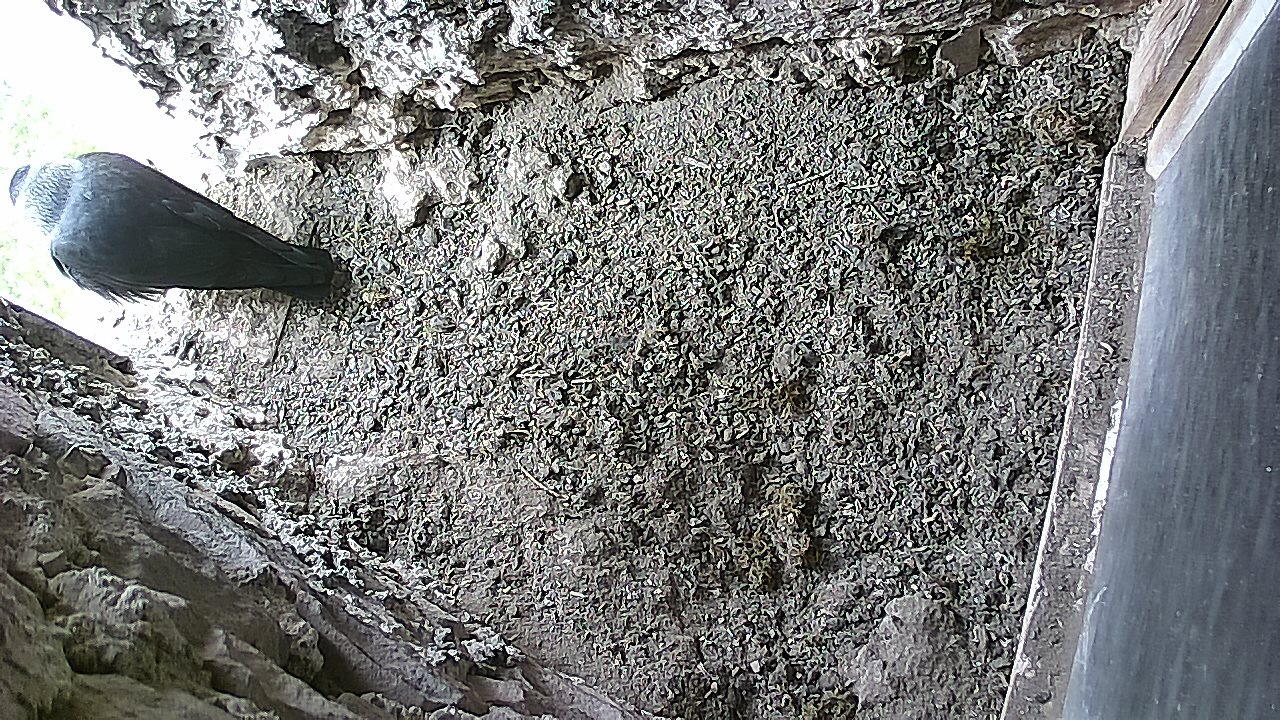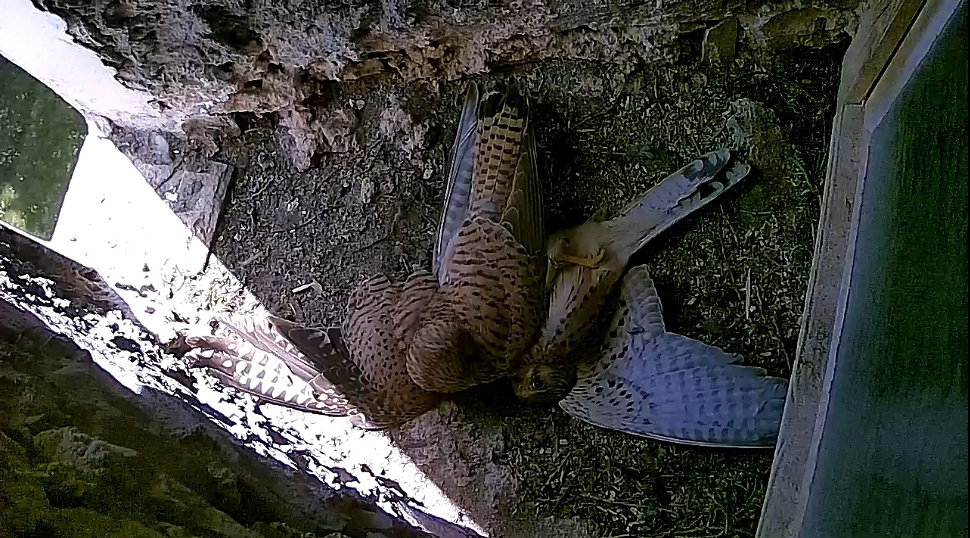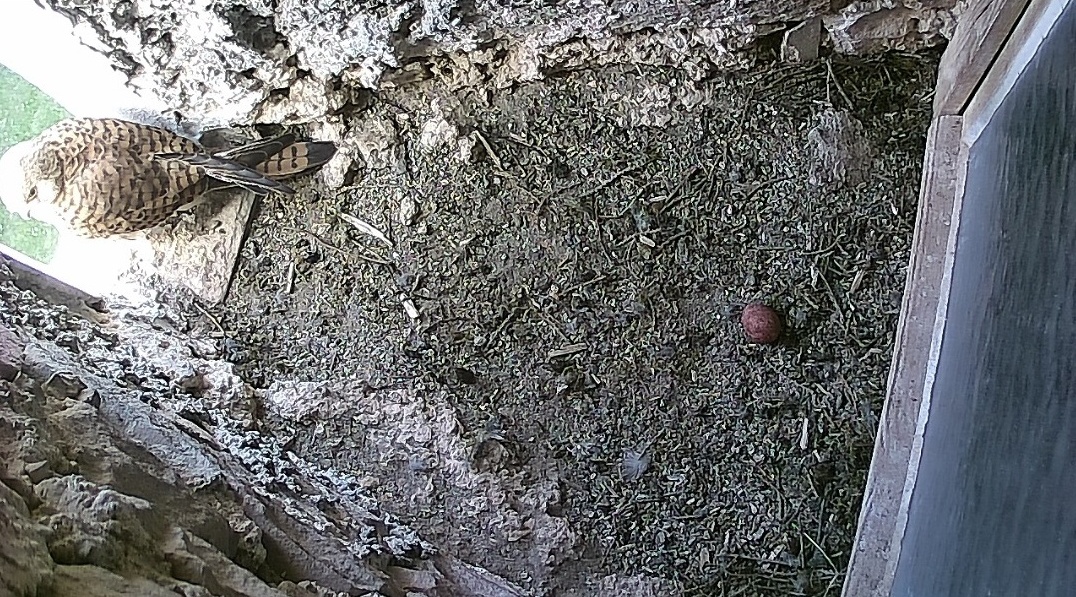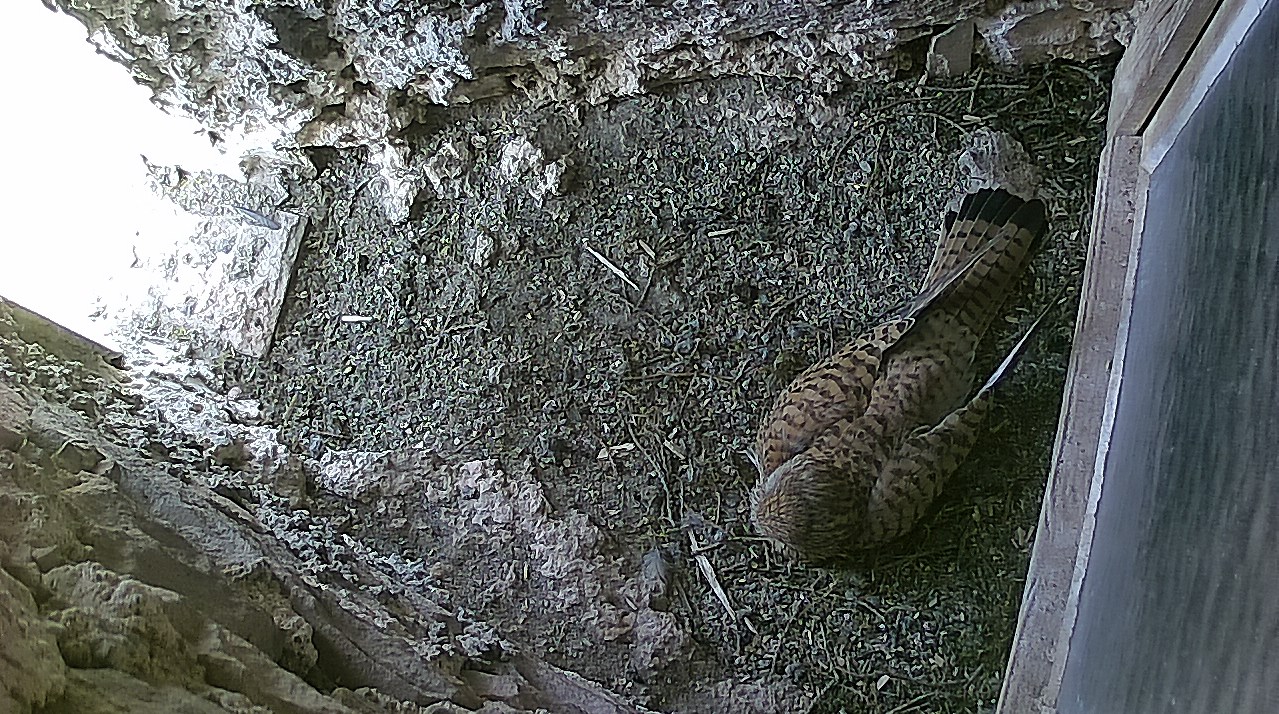
Deutsch
Kestrel Nesting-Diary 2024
Also this year the kestrel are lwatching out for their home. Now and then you can see them in the camera-niche of
the bell-tower. It is not yet regularly but it seems to be necessary to let the jackdaws know that this niche is in use.
It should now only be a few weeks before the first eggs are laid, and we will report back in good time.

We suspect that it is due to the temperatures that the falcons are rarely seen. The jackdaws take advantage of this
and the niche is now full of twigs and other nesting material. We will probably have to clean the niche again in the next few days....
The neighboring stork nest is also orphaned again. After a few days, first the female stork and then the male stork moved out.
We are curious to see whether a second pair will be found.
The nights are still relatively cold, close to the frost line, so the falcons are only occasionally seen in the churchyard during the day. We keep watching the jackdaws, some of which steal twigs from the storks in their eyrie and put them in the niche. We had already carried out an overdue clean-up last week, but the jackdaws won't give up. We're letting them have their way for now and assume that the falcons will eventually resolve the situation (or give up).




After 2 hot days, another rain front is forecast today. Over the last few days, the pair of falcons have been in the niche sporadically for short periods. Today, Ms. Falcon sits in front for a long time and watches the churchyard. Yes, we're actually waiting for the eggs to be laid, but even last year they didn't happen until the beginning of May.
We returned from our vacation yesterday and heard from afar that there had been some exciting scenes in the
niche of the church tower in the meantime. After the jackdaws had given up their persistent attempts to breed (which was apparently
related to the higher presence of the kestrel pair), there was probably a violent altercation between two female kestrels
yesterday. It is not entirely clear whether this took place immediately after an egg was laid. In any case, there is now an
apparently undamaged egg, which is also temporarily incubated or protected by a female kestrel. This would be an unusual
occurrence that we have not observed in the past, but understandable given the incident.



Kestrels normally lay 3 - 6 eggs at
intervals of 2 days, and breeding then begins towards the end of the egg-laying period.
The actual breeding then lasts around 30 days, after hatching the young are cared for and fed for a further 30 days. The start
of breeding depends on the weather, we have suspected for some time that a new pair had nested here. Perhaps the previous owners
had registered their claims relatively late.
Next door, the storks on the church gable also seem to have a persistent admirer who regularly settles down next to the nest.
The young could have hatched here by now. We would be delighted if it worked out for the first time this year.
A short report from the falcon's niche: The breeding continues, the tercel is also involved, but only a
little. However, he regularly provides Ms. Falcon with prey, which is usually handed over outside the niche. The young should
actually hatch in the next few days.
Next door, a single stork chick has been cared for for about 4 weeks, which has survived the heat of the last few days and
the heavy rain well (as far as we could see from a distance).
Yesterday and today a total of 4 falcon chicks hatched, everything is going according to plan, the young are being cared for by the parents, the next few days should be hot, but the mother falcon will still stay with the young most of the time.
Today, after days of heat, the temperatures were bearable. The little falcons are quite mobile, today we
were able to watch them in the evening as they cut up prey together without the help of their parents. This will certainly
change over the next few days, as the one with the biggest appetite or the most skillful usually wins.
Due to the high temperatures, the mother can only be seen in the alcove from time to time, even at night she often sleeps
outside, but certainly always within reach. We have often seen her in the trees opposite.
Everything seems to be going according to plan, the little ones are now more than 2 weeks old and their plumage is already
changing very quickly.
The young birds are getting bigger and bigger, their plumage changes almost daily. One or two move further and further forward to take a look at the surroundings and the churchyard. In good mice years, i.e. when there is sufficient food, there is no aggression among the young birds. Cleaning their beaks and catches can now increasingly be observed among them, this serves to create a sense of togetherness. An interesting scientific observation in passing: apparently pairs that start breeding late in the year predominantly have female offspring. This could be the case with our falcons this year, but we also suspect that the parents are a new pair of falcons.
So, the first young falcon flew out this morning before 10 o'clock, you could almost have guessed it yesterday. There were always dry flying exercises again and at least 2 of the quartet sat quite far forward at the exit. He then walked for a few minutes on the ledge below the niche, then tried to climb the steep church roof, which of course didn't work and ended with him landing in front of the snow guard. He sat there again for quite a long time, and two hours later he had disappeared (presumably into the trees). At around 3 p.m. he actually managed to retreat, which was a real feat, as none of the young falcons had managed to do this so early in recent years. The falcon parents also brought him prey from time to time, but the mouse landed in the gutter.

Yesterday was exciting, the first young falcon had flown out in the morning and the others were correspondingly excited. Around 9 o'clock the second one was out, the last two still needed a little time to think. At some point the niche was empty, they were not to be seen either, they were all sitting hidden in the trees. When the parents returned with food, it became noisy and one or the other came out of hiding. This year there has been little wind in the last few days, so there was no need to worry about any major crashes . Nevertheless, one or two tried to climb up the roof today, the jackdaws sat at an appropriate distance and watched the spectacle. The stork's nest has also been empty since yesterday, apparently the parents have now moved away (the little stork unfortunately didn't make it). As in previous years, the falcons are taking advantage of this to make short trips from the stork's nest to the tree and back again, which is very interesting to watch as they are all very motivated. One was sitting in the niche again this morning , but the church bells for the service drove him away. Everything looks very good....






It looked as if the young falcons and their parents had already left, but due to the heavy rainfall in recent days, you can still see one or two young falcons sitting at the exit of the niche from time to time. This morning there were two of them. However, their excursions are now taking longer and longer, and it will certainly not be long before they leave us for good.
